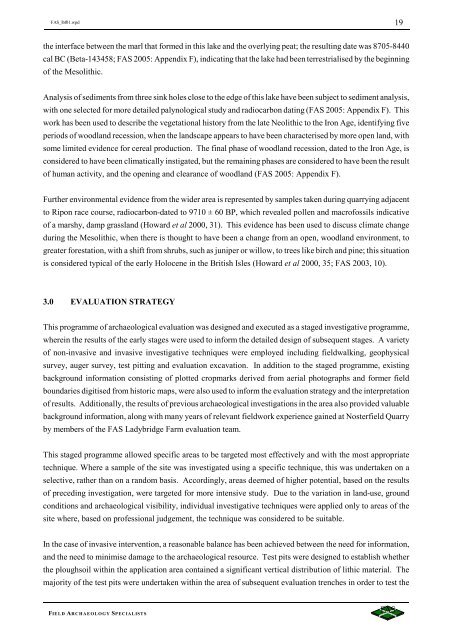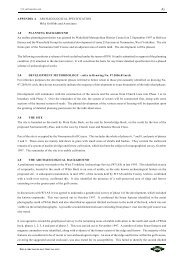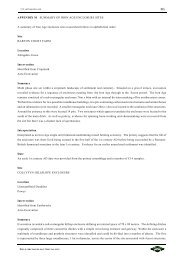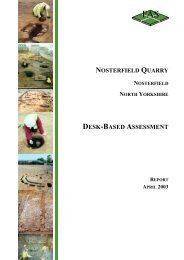ARCHAEOLOGICAL EVALUATION - Mike Griffiths and Associates
ARCHAEOLOGICAL EVALUATION - Mike Griffiths and Associates
ARCHAEOLOGICAL EVALUATION - Mike Griffiths and Associates
Create successful ePaper yourself
Turn your PDF publications into a flip-book with our unique Google optimized e-Paper software.
FAS_lbf01.wpd 19<br />
the interface between the marl that formed in this lake <strong>and</strong> the overlying peat; the resulting date was 8705-8440<br />
cal BC (Beta-143458; FAS 2005: Appendix F), indicating that the lake had been terrestrialised by the beginning<br />
of the Mesolithic.<br />
Analysis of sediments from three sink holes close to the edge of this lake have been subject to sediment analysis,<br />
with one selected for more detailed palynological study <strong>and</strong> radiocarbon dating (FAS 2005: Appendix F). This<br />
work has been used to describe the vegetational history from the late Neolithic to the Iron Age, identifying five<br />
periods of woodl<strong>and</strong> recession, when the l<strong>and</strong>scape appears to have been characterised by more open l<strong>and</strong>, with<br />
some limited evidence for cereal production. The final phase of woodl<strong>and</strong> recession, dated to the Iron Age, is<br />
considered to have been climatically instigated, but the remaining phases are considered to have been the result<br />
of human activity, <strong>and</strong> the opening <strong>and</strong> clearance of woodl<strong>and</strong> (FAS 2005: Appendix F).<br />
Further environmental evidence from the wider area is represented by samples taken during quarrying adjacent<br />
to Ripon race course, radiocarbon-dated to 9710 ± 60 BP, which revealed pollen <strong>and</strong> macrofossils indicative<br />
of a marshy, damp grassl<strong>and</strong> (Howard et al 2000, 31). This evidence has been used to discuss climate change<br />
during the Mesolithic, when there is thought to have been a change from an open, woodl<strong>and</strong> environment, to<br />
greater forestation, with a shift from shrubs, such as juniper or willow, to trees like birch <strong>and</strong> pine; this situation<br />
is considered typical of the early Holocene in the British Isles (Howard et al 2000, 35; FAS 2003, 10).<br />
3.0 <strong>EVALUATION</strong> STRATEGY<br />
This programme of archaeological evaluation was designed <strong>and</strong> executed as a staged investigative programme,<br />
wherein the results of the early stages were used to inform the detailed design of subsequent stages. A variety<br />
of non-invasive <strong>and</strong> invasive investigative techniques were employed including fieldwalking, geophysical<br />
survey, auger survey, test pitting <strong>and</strong> evaluation excavation. In addition to the staged programme, existing<br />
background information consisting of plotted cropmarks derived from aerial photographs <strong>and</strong> former field<br />
boundaries digitised from historic maps, were also used to inform the evaluation strategy <strong>and</strong> the interpretation<br />
of results. Additionally, the results of previous archaeological investigations in the area also provided valuable<br />
background information, along with many years of relevant fieldwork experience gained at Nosterfield Quarry<br />
by members of the FAS Ladybridge Farm evaluation team.<br />
This staged programme allowed specific areas to be targeted most effectively <strong>and</strong> with the most appropriate<br />
technique. Where a sample of the site was investigated using a specific technique, this was undertaken on a<br />
selective, rather than on a r<strong>and</strong>om basis. Accordingly, areas deemed of higher potential, based on the results<br />
of preceding investigation, were targeted for more intensive study. Due to the variation in l<strong>and</strong>-use, ground<br />
conditions <strong>and</strong> archaeological visibility, individual investigative techniques were applied only to areas of the<br />
site where, based on professional judgement, the technique was considered to be suitable.<br />
In the case of invasive intervention, a reasonable balance has been achieved between the need for information,<br />
<strong>and</strong> the need to minimise damage to the archaeological resource. Test pits were designed to establish whether<br />
the ploughsoil within the application area contained a significant vertical distribution of lithic material. The<br />
majority of the test pits were undertaken within the area of subsequent evaluation trenches in order to test the<br />
FIELD ARCHAEOLOGY SPECIALISTS







